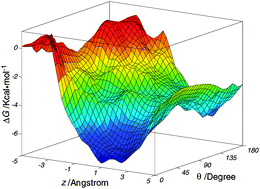In this work, a new procedure has been developed in order to realize the self-consistent-reaction field computation for interfacial molecules. Based on the extension of the dielectric polarizable continuum model, the quantum-continuum calculations for interfacial molecules have been carried out. This work presents an investigation into how the molecular structure influences the adsorbate–solvent interaction and consequently alters the orientation angle at the air/water interface. Taking both electrostatic and non-electrostatic energies into account, we investigate the orientation behavior of three interfacial molecules, 2,6-dimethyl-4-hydroxy-benzonitrile, 3,5-dimethyl-4-hydroxy-benzonitrile and p-cyanophenol, at the air/water interface. The results show that the hydrophilic hydroxyl groups in 2,6-dimethyl-4-hydroxy-benzonitrile and in p-cyanophenol point from the air to the water side, but the hydroxyl group in 3,5-dimethyl-4-hydroxy-benzonitrile takes the opposite direction. Our detailed analysis reveals that the opposite orientation of 3,5-dimethyl-4-hydroxy-benzonitrile results mainly from the cavitation energy. The different orientations of the hydrophilic hydroxyl group indicate the competition of electrostatic and cavitation energies. The theoretical prediction gives a satisfied explanation of the most recent sum frequency generation measurement for these molecules at the interface.

You have access to this article
 Please wait while we load your content...
Something went wrong. Try again?
Please wait while we load your content...
Something went wrong. Try again?


 Please wait while we load your content...
Please wait while we load your content...